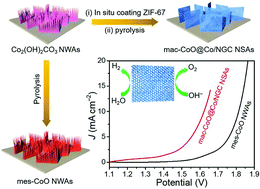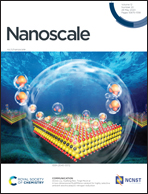Engineering cobalt oxide by interfaces and pore architectures for enhanced electrocatalytic performance for overall water splitting†
Abstract
The development of efficient electrocatalysts for overall water splitting is important for future renewable energy systems. Herein, macroporous CoO covered by Co/N-doped graphitic carbon nanosheet arrays (mac-CoO@Co/NGC NSAs) were constructed by engineering a mesoporous CoO nanowire (mes-CoO NWAs) core with highly conductive Co nanoparticles coated by a N-doped graphitic carbon (Co/NGC) shell. The in situ derived Co/NGC shell not only introduces electrocatalytic active sites for the hydrogen evolution reaction (HER) but also promotes the oxygen evolution reaction (OER) through the strong interaction between the CoO core and the Co/NGC shell. Moreover, the highly conductive Co/NGC shell crosslinks the isolated mesoporous CoO nanowires into a nanosheet rich in macropores, ensuring effective electron and mass transfer. Furthermore, the chemically stable N-doped graphitic carbon layer and physically stable hierarchical nanosheet arrays ensure the stability of the catalyst. Owing to the desirable interfaces and pore architecture, the as-prepared mac-CoO@Co/NGC NSAs can serve as highly effective, binder-free electrocatalysts for overall water splitting with a stable cell voltage of 1.62 V at 10 mA cm−2 for 35 h.



 Please wait while we load your content...
Please wait while we load your content...